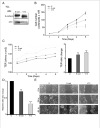Aberrant amplification of the crosstalk between canonical Wnt signaling and N-glycosylation gene DPAGT1 promotes oral cancer
- PMID: 22341307
- PMCID: PMC3362683
- DOI: 10.1016/j.oraloncology.2012.01.010
Aberrant amplification of the crosstalk between canonical Wnt signaling and N-glycosylation gene DPAGT1 promotes oral cancer
Abstract
Oral cancer is one of the most aggressive epithelial malignancies, whose incidence is on the rise. Previous studies have shown that in a subset of human oral squamous cell carcinoma (OSCC) tumor specimens, overexpression of the DPAGT1 gene, encoding the dolichol-P-dependent N-acetylglucoseamine-1-phosphate transferase, a key regulator of the metabolic pathway of protein N-glycosylation, drives tumor cell discohesion by inhibiting E-cadherin adhesive function. Recently, we reported that DPAGT1 was a target of the canonical Wnt signaling pathway. Here, we link overexpression of DPAGT1 in human OSCC tumor specimens to aberrant activation of canonical Wnt signaling. We report dramatic increases in β- and γ-catenins at the DPAGT1 promoter and correlate them with reduced expression of a Wnt inhibitor, Dickkopf-1 (Dkk-1). Using human squamous carcinoma cell lines of the head and neck, we show that partial inhibition of DPAGT1 reduces canonical Wnt signaling, indicating that DPAGT1 and canonical Wnt signaling function in a positive feedback loop. We provide evidence that E-cadherin inhibits DPAGT1, canonical Wnt signaling and the OSCC cancer phenotype by depleting nuclear β- and γ-catenins, with hypoglycosylated E-cadherin being the most effective. This suggests that in human OSCC, extensive N-glycosylation of E-cadherin compromises its ability to inhibit canonical Wnt signaling and DPAGT1 expression. Our studies reveal a novel interplay between DPAGT1/N-glycosylation and canonical Wnt signaling and suggest that dysregulation of this crosstalk is a key mechanism underlying OSCC. They also suggest that partial inhibition of DPAGT1 may represent an effective way to restore normal interactions among these essential pathways in oral cancer.
Published by Elsevier Ltd.
Figures







Similar articles
-
Protein N-glycosylation in oral cancer: dysregulated cellular networks among DPAGT1, E-cadherin adhesion and canonical Wnt signaling.Glycobiology. 2014 Jul;24(7):579-91. doi: 10.1093/glycob/cwu031. Epub 2014 Apr 17. Glycobiology. 2014. PMID: 24742667 Free PMC article. Review.
-
N-glycosylation induces the CTHRC1 protein and drives oral cancer cell migration.J Biol Chem. 2013 Jul 12;288(28):20217-27. doi: 10.1074/jbc.M113.473785. Epub 2013 May 23. J Biol Chem. 2013. PMID: 23703614 Free PMC article.
-
Coordinate regulation of N-glycosylation gene DPAGT1, canonical Wnt signaling and E-cadherin adhesion.J Cell Sci. 2013 Jan 15;126(Pt 2):484-96. doi: 10.1242/jcs.113035. Epub 2012 Nov 23. J Cell Sci. 2013. PMID: 23178939 Free PMC article.
-
Overexpression of DPAGT1 leads to aberrant N-glycosylation of E-cadherin and cellular discohesion in oral cancer.Cancer Res. 2009 Jul 15;69(14):5673-80. doi: 10.1158/0008-5472.CAN-08-4512. Epub 2009 Jun 23. Cancer Res. 2009. PMID: 19549906 Free PMC article.
-
A possible role for the WNT-1 pathway in oral carcinogenesis.Crit Rev Oral Biol Med. 2001;12(2):152-65. doi: 10.1177/10454411010120020501. Crit Rev Oral Biol Med. 2001. PMID: 11345525 Review.
Cited by
-
The Significance of the Dysregulation of Canonical Wnt Signaling in Head and Neck Squamous Cell Carcinomas.Cells. 2020 Mar 15;9(3):723. doi: 10.3390/cells9030723. Cells. 2020. PMID: 32183420 Free PMC article. Review.
-
The relationship of N-glycosylation and porcine duodenal morphology and function.J Anim Sci. 2025 Jan 4;103:skaf087. doi: 10.1093/jas/skaf087. J Anim Sci. 2025. PMID: 40123525
-
A YAP/TAZ-Regulated Molecular Signature Is Associated with Oral Squamous Cell Carcinoma.Mol Cancer Res. 2015 Jun;13(6):957-68. doi: 10.1158/1541-7786.MCR-14-0580. Epub 2015 Mar 20. Mol Cancer Res. 2015. PMID: 25794680 Free PMC article.
-
The Integrated Role of Wnt/β-Catenin, N-Glycosylation, and E-Cadherin-Mediated Adhesion in Network Dynamics.PLoS Comput Biol. 2016 Jul 18;12(7):e1005007. doi: 10.1371/journal.pcbi.1005007. eCollection 2016 Jul. PLoS Comput Biol. 2016. PMID: 27427963 Free PMC article.
-
Protein N-glycosylation in oral cancer: dysregulated cellular networks among DPAGT1, E-cadherin adhesion and canonical Wnt signaling.Glycobiology. 2014 Jul;24(7):579-91. doi: 10.1093/glycob/cwu031. Epub 2014 Apr 17. Glycobiology. 2014. PMID: 24742667 Free PMC article. Review.
References
-
- Choi S, Myers JN. Molecular pathogenesis of oral squamous cell carcinoma: implications for therapy. J Dent Res. 2008;87:14–32. - PubMed
-
- Zuo J-H, Zhu W, Li M-Y, Li X-H, Yi H, Zeng G-Q, et al. Activation of EGFR Promotes Squamous Carcinoma SCC10A Cell Migration and Invasion via Inducins EMT-like PhenotypeCHange and MMP-9-Mediated Degradation of E-cadherin. J Cell Biochem. 2011;112:2508–17. - PubMed
Publication types
MeSH terms
Substances
Grants and funding
LinkOut - more resources
Full Text Sources
Medical

